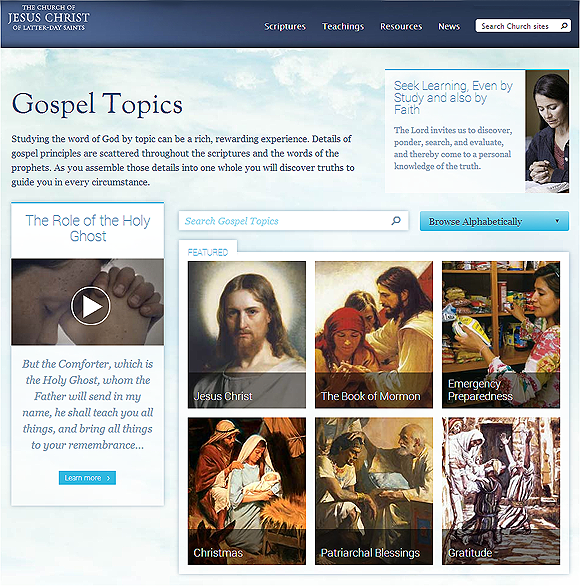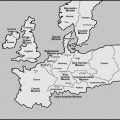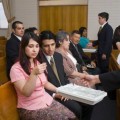Recently, the Mormons have made changes to a section of their official website, LDS.org, which enable both Mormons and curious people of other faiths to find out what Mormons believe on a wide range of topics.
The Study by Topics section has existed for a very long time, but it now has a new look and includes some in-depth studies of some topics considered controversial. More of these in-depth evaluations will be added over time. The media has taken note of the recent sections on race and priesthood, the multiple versions of Joseph Smith’s First Vision accounts and polygamy.
 The changes are part of a growing effort to help Mormon families understand issues often covered—usually incorrectly—by non-Mormons on the Internet. Frequently, articles written by those hoping to discredit the Church contain inaccurate or incomplete information that can confuse Mormons who may not be aware of the issues. The new resources are particularly valuable to teenagers, who may be starting to evaluate their childhood faith in new ways and are learning subjects not taught to younger children.
The changes are part of a growing effort to help Mormon families understand issues often covered—usually incorrectly—by non-Mormons on the Internet. Frequently, articles written by those hoping to discredit the Church contain inaccurate or incomplete information that can confuse Mormons who may not be aware of the issues. The new resources are particularly valuable to teenagers, who may be starting to evaluate their childhood faith in new ways and are learning subjects not taught to younger children.
In general, the material found in the articles is not new. Mormons who enjoy studying these topics in-depth are already familiar with the information. It has simply not been previously gathered into one place. The articles use outside resources as well as internal resources, a move that is new. Religious scholars were invited to assist with the research and writing. It is helping to clear up some cultural myths that circulated among Church members, many of whom did not know the stories were personal theories of some people, and not official doctrine.
The new material will be especially beneficial to teenagers. The Church recently launched a new youth program that teaches teenagers to research the answers to their questions, rather than simply being told the answers. In their classes, they are given a question and the teacher helps them learn how to find the answers from a variety of reliable sources. They generally break into small groups to research and then the teenagers teach each other what they learned, rather than listening to their teacher, who serves in the capacity of a moderator. The goal is to make them self-reliant in finding answers to their questions. Since the articles on the Study by Topics page include lists of additional resources, these pages will be valuable resources for the teachers and students in the youth program.
The article on plural marriage explains that the practice began as the result of a revelation given through Joseph Smith, the first Mormon prophet. We don’t always know the reasons God commands us to do things, but the article suggests a few possibilities, including the need to build the population of Mormons to a sustainable level, which it did do. The article then offers some context: explanations of how polygamy worked among the early Mormons, how women felt about it, and what happened if the marriage did not work out. It notes the problems that arose, but also noted certain benefits. Nearly all women who wished to marry had the opportunity to do so. There were many multicultural marriages, which helped immigrant women to more quickly find their place in the community and to learn the language and culture. The essay also notes that it was a minority practice, not something everyone was required to do, and most men had no more than two wives. The article goes on to address acts of civil disobedience practiced by some church members prior to 1904, when all plural marriages were prohibited. Today, Mormons who adopt polygamy are excommunicated, even in countries where it is legal.
The article on the versions of the First Vision discuss Joseph Smith’s vision, which occurred in 1820, when Joseph was fourteen. He had been struggling with a decision about which church to join. He could not figure out which one was God’s true church. After reading James 1:5 in the King James translation of the Bible, which said that we can ask God for the wisdom we seek, he decided to pray. He went into the woods to pray for an answer and received a visit from God and Jesus Christ. God introduced His Son, who instructed Joseph not to join any church because the fullness of the gospel was not yet on the Earth. Later, when he was a young adult, he would be called by God to become the first prophet of the restoration of the gospel of Jesus Christ.
Many have claimed the Church hides the fact that there are multiple versions of the vision. In fact, information about this has long been available to Church members. College students are given resources on the subject when they take a church history class and the manual is available free online. A professor of Church history at Mormon-owned Brigham Young University wrote an analysis of the accounts in 1985, which appeared in the monthly Church magazine for adults. (See Milton V. Backman, Jr., Joseph Smith’s Recitals of the First Vision, Ensign, January 1982.) An article appeared in a 1970 edition of a Church magazine that no longer exists. In fact, many articles discussing these versions have been presented to Church members who chose to read them.
The new article on LDS.org outlines each of the versions, both those told by Joseph and the versions that were second-hand reports from people who knew him. Each is given context to help readers understand the circumstances surrounding the report. The article offers a straightforward list of the arguments outsiders use to discredit the accounts and then explains the arguments that support them. The article concludes with a list of resources for further study, including books not published by the Mormons.
A third article outlines issues surrounding race and priesthood. The article explains how church structure encourages integrated congregations and notes that today, people of any race may hold the priesthood. Although blacks held the priesthood under the leadership of Joseph Smith, Brigham Young ended that practice during his time as president of the Church. Priesthood and temple rights were restored in 1978 under Spencer W. Kimball. Some church members developed personal theories as to why the ban existed and some of these gained prominence among individual members, most based on Protestant and cultural traditions that influenced converts to Mormonism, even though they were never official church doctrine.
The article evaluates these false theories and also the history of the ban:
“Today, the Church disavows the theories advanced in the past that black skin is a sign of divine disfavor or curse, or that it reflects actions in a premortal life; that mixed-race marriages are a sin; or that blacks or people of any other race or ethnicity are inferior in any way to anyone else. Church leaders today unequivocally condemn all racism, past and present, in any form” (Race and the Priesthood).
These articles gather up the various pieces of information formerly scattered throughout the site and introduce some new scholarship to help present a concise outline of the issues and to help both Mormons and non-Mormons find additional resources for study. They are a valuable addition to an already highly informative website for those seeking authentic information about Mormonism.
About Terrie Lynn Bittner
The late Terrie Lynn Bittner—beloved wife, mother, grandmother, and friend—was the author of two homeschooling books and numerous articles, including several that appeared in Latter-day Saint magazines. She became a member of the Church at the age of 17 and began sharing her faith online in 1992.





